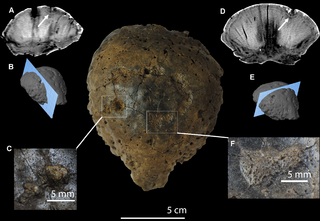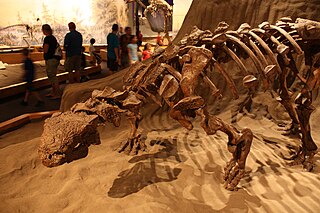
The beardfishes consist of a single extant genus, Polymixia, of deep-sea marine ray-finned fish named for their pair of long hyoid barbels. They are classified in their own order Polymixiiformes. But as Nelson says, "few groups have been shifted back and forth as frequently as this one, and they were recently added to Paracanthoptergii". For instance, they have previously been classified as belonging to the Beryciformes, and are presently considered either paracanthopterygians or the sister group to acanthopterygians. They are of little economic importance.

Xiphactinus is an extinct genus of large predatory marine ray-finned fish that lived during the late Albian to the late Maastrichtian. The genus grew up to 5–6 metres (16–20 ft) in length, and superficially resembled a gargantuan, fanged tarpon. It is a member of the extinct order Ichthyodectiformes, which represent close relatives of modern teleosts.

Caenagnathus is a genus of caenagnathid oviraptorosaurian dinosaur from the late Cretaceous period. It is known from partial remains including lower jaws, a tail vertebra, hand bones, hind limbs, and pelvis, all found in the Dinosaur Park Formation of Alberta, Canada.

Hanssuesia is a genus of pachycephalosaurid dinosaurs from the late Cretaceous period. It lived in what is now Alberta and Montana, and contains the single species Hanssuesia sternbergi.

Gravitholus was a genus of pachycephalosaurid dinosaur from the late Cretaceous period. It was a pachycephalosaur, and like other pachycephalosaurids the skull roof formed a thick dome made of dense bone, which may have been used in head-butting contests over mates or territory. It lived in what is now Alberta, Canada, and was described in 1979 by W. P. Wall and Peter Galton. The type species is Gravitholus albertae.

Elmisaurus is an extinct genus of caenagnathid dinosaur from the Late Cretaceous Nemegt Formation of Mongolia. It was a theropod belonging to the Oviraptorosauria.

Berycopsis is an extinct genus of marine ray-finned fish from the Late Cretaceous period. Fossils are known from England, Germany, and Lebanon. A potential specimen is known from the Czech Republic.

Dercetis is a genus of prehistoric marine ray-finned fish. It is the type genus of the family Dercetidae, a group of slender, elongate aulopiforms, which were related to modern lizardfish and grinners. It is known from the Late Cretaceous of Europe, the Middle East, and western North America.
Caproberyx is an extinct genus of marine acanthomorph ray-finned fish, possibly a holocentrid, from the Late Cretaceous.

Aulolepis is an extinct genus of prehistoric marine ray-finned fish that lived from the middle Cenomanian to the late Turonian. It contains a single species, A. typus from the Chalk Group of the United Kingdom and the Hesseltal Formation of Germany.
Ctenocephalichthys is an extinct genus of prehistoric marine ray-finned fish, generally considered a holocentriform, that lived during the Late Cretaceous. It is known from Cenomanian to the Santonian of Lebanon.
Dinopteryx is an extinct genus of prehistoric beardfish from the Late Cretaceous period. It contains a single species, D. spinosus, known from the Santonian of Lebanon. It is the only member of the extinct family Dinopterygidae, which is considered a distinct family of the Polymixiiformes. It was previously placed in the genus Hoplopteryx.

Alloberyx is an extinct genus of prehistoric marine ray-finned fish, possibly a holocentrid, that lived during the Santonian of Lebanon, from the Sahel Alma site. It contains two species, A. syriacus, initially described as a species of Pseudoberyx, and A. robustus, initially classified in the genus Serratocentrus.
Cryptoberyx is an extinct genus of prehistoric marine ray-finned fish that lived during the late Cenomanian stage of the Late Cretaceous. Two species are known from southern Europe and the Middle East, both part of the former Tethys Sea.
Adriacentrus is an extinct genus of prehistoric marine bony fish that lived in the Turonian in what is now Croatia. It contains a single species, A. crnolataci. Formerly considered a beryciform fish, it is now known to be more closely related to the squirrelfish (Holocentridae).
Dalmatichthys is an extinct genus of marine beardfish from the Late Cretaceous. It contains a single species, D. malezi from Croatia. It is the only member of the family Dalmatichthyidae, which is sometimes considered synonymous with Polymixiidae. Its exact relationship to modern beardfish in Polymixia likely needs further research.

Ankylosaurinae is a subfamily of ankylosaurid dinosaurs, existing from the Early Cretaceous about 105 million years ago until the end of the Late Cretaceous, about 66 mya. Many genera are included in the clade, such as Ankylosaurus, Pinacosaurus, Euoplocephalus, and Saichania.

The Sannine Formation, also called the Sannine Limestone, is a Cretaceous geologic formation in Lebanon. It is a Konservat-Lagerstätte that contains a high diversity of well-preserved fish, reptiles, and invertebrates from the Tethys Ocean within its three main localities: Haqel, Hjoula, and Nammoura.
Sahel Alma or Sahel Aalma is a Late Cretaceous paleontological site and Konservat-Lagerstätte in Keserwan-Jbeil, Lebanon. Located near the town of the same name, it documents well-preserved deepwater marine fossils dating to the late Santonian stage of the Cretaceous. It is often associated with the slightly older, similarly famous Sannine Formation sites, with these four sites being together referred to as the "Fish Beds" of Lebanon.











